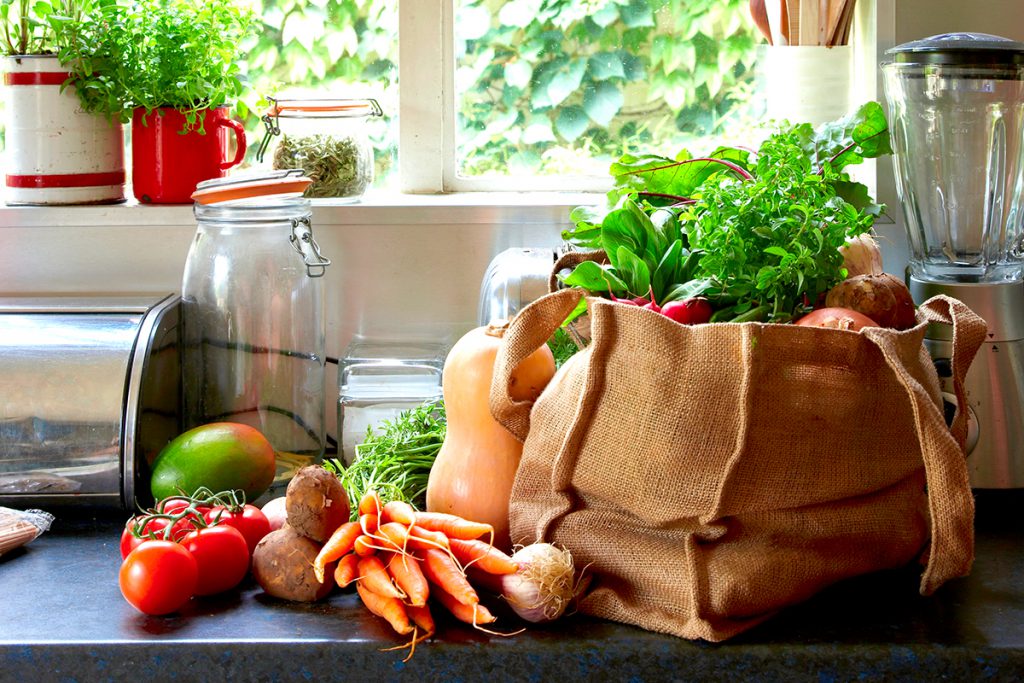8 Ways to Save Money on Groceries That Aren’t Coupons
Adopt these insider tips to lower your grocery bill, whether you shop online or in store.

Grocery shopping isn’t what it used to be. For many people, the coronavirus pandemic meant trading walks down the aisles for curbside pickups or contactless deliveries.
In fact, grocery delivery and pickup sales in the U.S. surged from $1.2 billion in June 2019 to $7.2 billion in June 2020—a 600 percent increase!
Whether the online shopping trend continues is yet to be determined, but there’s no doubt you’ll be buying groceries one way or another. That’s why we asked a variety of grocery shopping pros—from dietitians to supermarket veterans—for their best money-saving advice.
Adopt these tips to dramatically bring down your bill, whether you shop online or in stores.
Money-Saving Tip #1: Choose Curbside Pickup Over Delivery
When you opt for a delivery service, the price you’re charged for groceries may be more than what you’d pay in store. Instacart, one of the largest grocery delivery services in the U.S., acknowledges the prices on their platform may differ from those available to in-store shoppers on their website.
“At Costco, for instance, the prices are about 20 percent higher on Instacart,” says Jeff Campbell, a former store team leader at Whole Foods Market and founder of The Grocery Store Guy. “It’s not always obvious unless you’re really familiar with pricing.”
If you’re looking to save money while also avoiding crowds, curbside pickup is your best bet. Many major supermarket chains offer the service for free, while some require a minimum purchase. For example, Kroger offers free curbside pickup on orders over $35, while Walmart does it on grocery orders over $30.
Money-Saving Tip #2: Don’t Assume Generic Brands Are Cheaper
It’s understandable to expect the store brand to be the least expensive option. After all, they don’t spend money on advertising, and they can pass those savings on to the consumer. But that’s not always the case.
“It depends on how much that store is purchasing from the packer providing the private label,” Campbell says. “It could be that Hellmann’s mayonnaise does so much volume that the store brand might not be able to compete on price.”
To find the best deal, compare the unit price (typically the price per ounce, pound, or count) for different brands. The unit price is usually found on the left side of the price tag and may be highlighted in a bright color, such as orange or yellow. As long as the unit of measure is the same, you can easily compare prices of different brands to find the best buy.
Money-Saving Tip #3: Look at the Top and Bottom Shelf
Next time you go to a grocery store, take a moment to see how items are displayed on the shelves. Chances are, the most expensive and profitable items are at eye level.
“Shelf placement isn’t random,” says Chrissy Arsenault, R.D.N., owner of The Pink Pamplemousse. “Everything at eye level is considered ‘buy level.’ When we’re shopping, we don’t have enough time to weigh all of the options, so we often buy whatever is most easily accessible.”
To counter this psychological trick—and save money—take a few extra seconds to scan the items on the top and bottom shelves. If you’re not tall enough to reach the upper shelves or have trouble bending down to access the lower shelves, ask a store employee for assistance.
Money-Saving Tip #4: Ask the Manager When Items Are Marked Down
Some grocery stores mark down perishable food as they near expiration, while others donate the items to local organizations that fight hunger. To find out if your local store offers discounts, call and ask to speak to the manager, suggests Stephanie Schill, a personal finance blogger at Intentional Saver. She’s found the best deals in the meat and bakery departments, which often mark down items on a daily basis.
As long you plan on using these items soon or freezing them, it’s a great way to cut your grocery bill. Need a refresher on food safety? Check out these fixes for the most common mistakes.
Money-Saving Tip #5: Don’t Buy the Whole Bunch of Bananas
How many times do you buy produce that goes bad before you can finish it? It’s an all-too-common problem, especially if you’re shopping for one or two people. As long as the produce is being sold by weight, you can take what you want and leave the rest behind, Campbell says. This is a great cost-saving tip when buying things like bananas or grapes (yes, you can break up the bunch).
In some stores, this principle also extends to the meat department. If you’re shopping at a store with a meat counter and the prepackaged options are all too big, it’s completely reasonable to ask the butcher to make you a smaller portion, Campbell says.
Money-Saving Tip #6: Look Up Substitutions for Expensive Ingredients
We’ve all been there: You’re getting ready to make a new recipe and realize you’re missing an ingredient. Before you go to the store or click “buy now,” consider whether the ingredient is something you’ll use frequently. If it’s not, try typing “alternative to [ingredient name]” into Google.
Subscribe to our newsletter
It's quick and easy. You could be one of the 13 million people who are eligible.
Already a member? Click to discover our 15,000+ participating locations.
Follow Us
A quick online search often yields pantry staples that can be used in lieu of specialty ingredients, says Colleen Christensen, R.D.N., founder of Colleen Christensen Nutrition. “It depends on the recipe, but I try to substitute with other common flavors from that cuisine,” she says. “For example, if I’m making a stir-fry that calls for a paste I don’t think I’m going to use again, I’d probably use soy sauce or oyster sauce to give that savory flavor I’m looking for.”
Money-Saving Tip #7: Download Free Cash-Back Apps
Coupon clipping is time-consuming, and you may be enticed to buy products you don’t need. Cash-back apps, on the other hand, offer similar benefits for minimal effort.
Schill recommends Fetch Rewards. Once you download the free app, simply take a photo of your receipt to earn points for the purchases you’ve made. Those points can be used to redeem gift cards from dozens of stores, including Starbucks, Amazon, and Apple.
“The nice thing is that you get 25 points if you scan any receipt, whether you have a qualifying item or not,” Schill says. She recommends using the app after you’ve finished grocery shopping, rather than scouting the offers ahead of time. That way, you’ll get points for the purchases you want and need, rather than chasing a deal that may end up costing you more in the long run.
Money-Saving Tip #8: Shop Pharmacies and Hardware Stores
Grocery and convenience stores aren’t the only places that sell food these days. You can buy a lot of pantry staples, including milk, eggs, and canned goods at most pharmacies and even some hardware stores, like Menards, Schill says.
“They certainly don’t have a huge selection, but I’ve seen them have some really good deals,” she adds. It’s worth checking the next time you need to pick up a prescription or a plunger.
Take Your Favorite SilverSneakers Classes Online!
SilverSneakers members can access live fitness classes and wellness workshops through SilverSneakers LIVE. See the latest schedule and RSVP for classes here.
Not a member? If you have a Medicare Plan, it may include SilverSneakers—at no additional cost. Check your eligibility instantly here.





